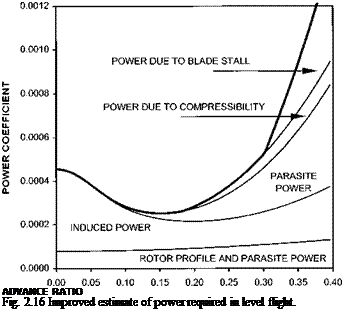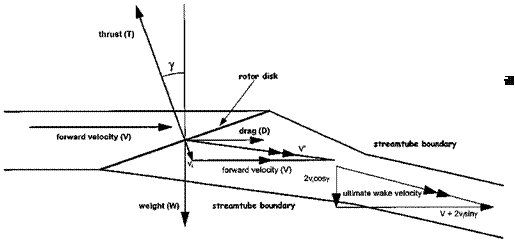From Fig. 2.13 the elemental rotor profile power is given by:
SP = ) 82 = )r 8D = )r1 p()r + Vsin ^)2c Sr CD
The profile power can be obtained by multiplying SP by the number of blades, b, and integrating both along the radius and around the azimuth:
1 P 1
Ppr = 2^b I I 2P )rCD()r + Vsin^)2cdrd^
1 1 C2n P
Ppr = — pbc) 2 CD I I r()2r2 + 2 Vr sin ^ + V2 sin2 ^)dr d^
Jo Jo
Thus from Layton [2.4]:
PPr = 8 pbcVT RCD(1 + P) (2.13)
Comparison with Equation (2.6) shows that the profile power in horizontal flight can be found by calculating the profile power required in the hover and scaling it by a factor equal to (1 + p).
1.7.2 Rotor parasite power
Likewise from Fig. 2.13 the elemental rotor parasite power is given by:
SP = VSH = VSD sin t = V2 p()r + Vsin tP Sr CD sin t Therefore:
Ppar = 4 pbcV3 RCDp2 (2.14)
1.7.3 Power required for horizontal flight
We are now in a position to determine the power required for horizontal flight using Equations (2.11), (2.13) and (2.14). It is customary to add the contribution from rotor parasite power to the rotor profile power rather than the fuselage parasite power. Thus:
P = T(Vsin у + vi) +1 pbcRVf CD(1 + p2) +1 pbcRVT CDp2 8 4
P = 2 p V3f + Tvi + 8 pbcRVT CD(1 + 3p2) and in coefficient terms:
Cp = 1P3 f + XCT +1 "CD(1 + 3p2) (2.15)
Equation (2.15) is another important result since it suggests that for a helicopter (fixed f /A) at a given weight (fixed CT) the power coefficient will depend solely on the advance ratio (p). Also if the advance ratio is fixed and the rotor profile drag coefficient is constant then the power required to drive the rotor will vary as ) so that CP remains unchanged. This relationship gives us a mechanism for assessing the effect of changes in rotor drag on the level flight performance of a helicopter.
![]() Cp = L2XCT + — p3 — + p sCd(1 + 43p2) + Cpm + Cp,
Cp = L2XCT + — p3 — + p sCd(1 + 43p2) + Cpm + Cp,

















